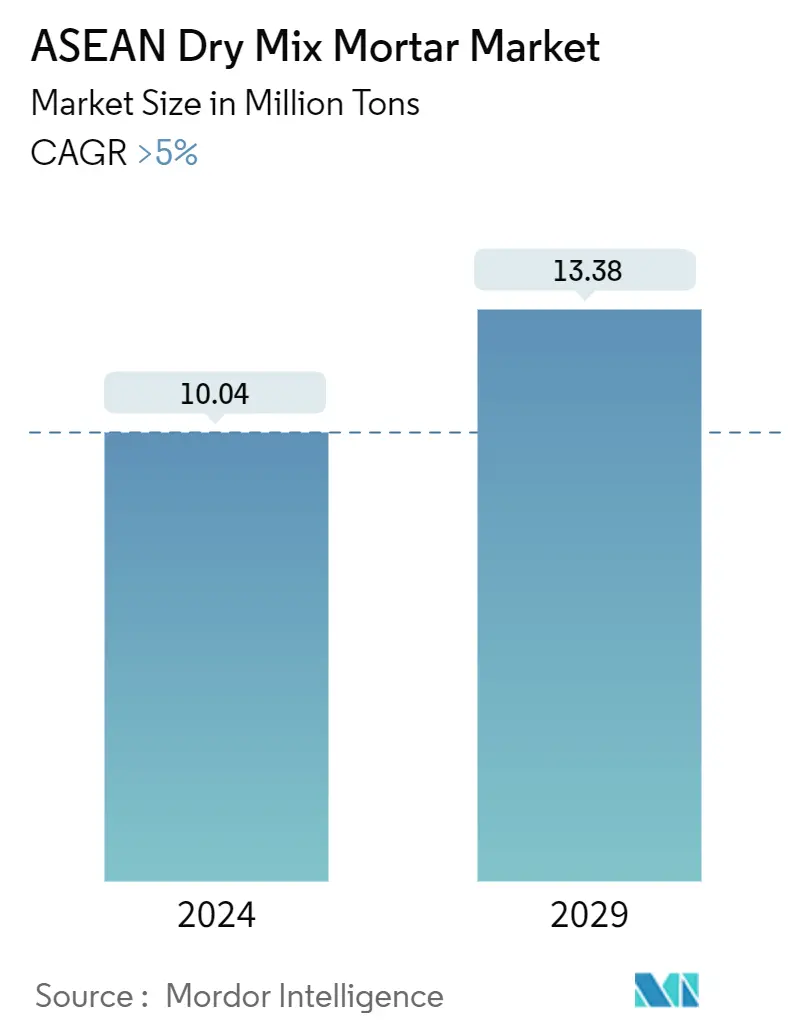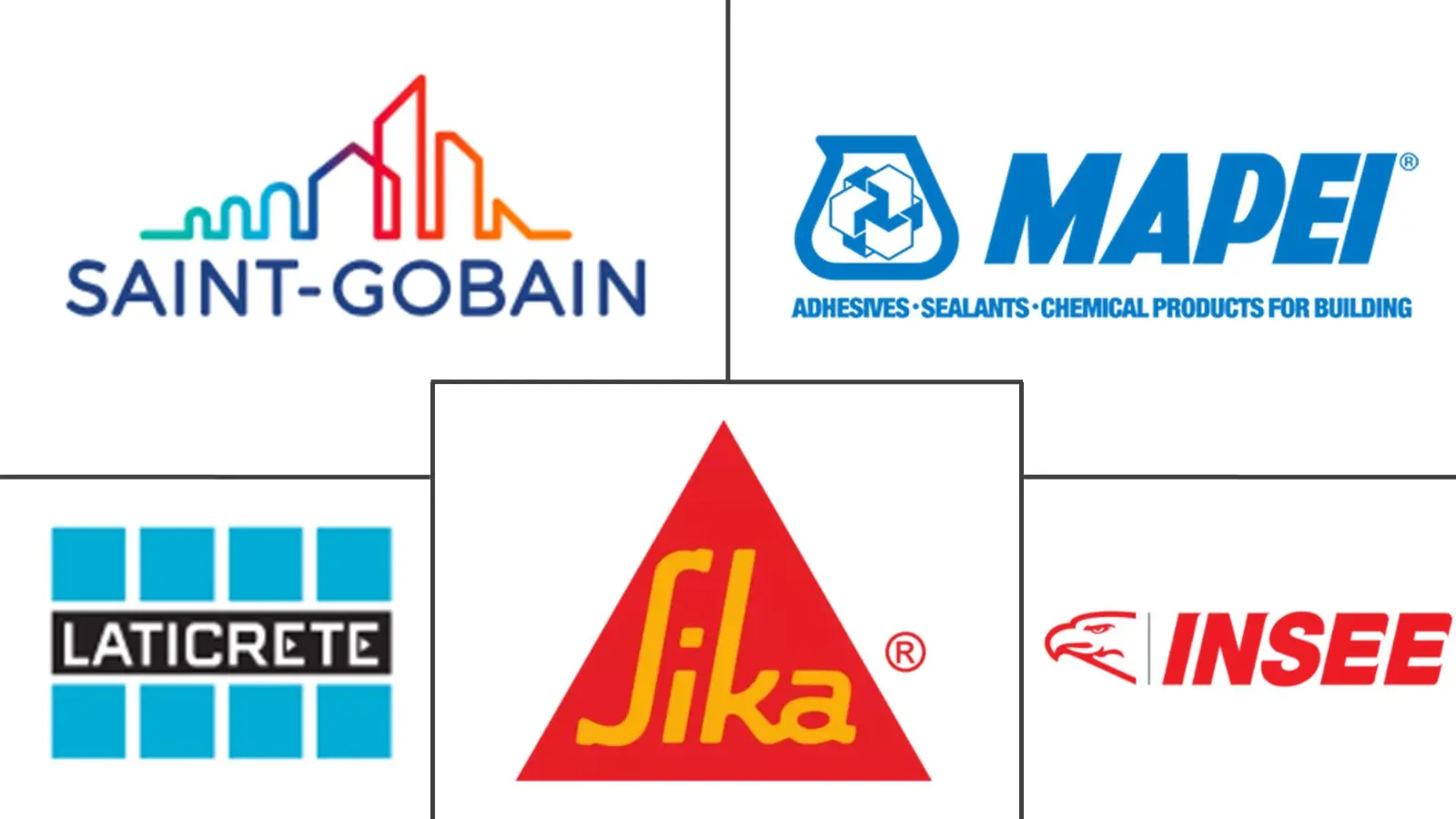Market Size of ASEAN Dry Mix Mortar Industry

| Study Period | 2019-2029 |
| Base Year For Estimation | 2023 |
| Market Volume (2024) | 10.04 Million tons |
| Market Volume (2029) | 13.38 Million tons |
| CAGR (2024 - 2029) | > 5.00 % |
| Market Concentration | Medium |
Major Players
*Disclaimer: Major Players sorted in no particular order |
ASEAN Dry Mix Mortar Market Analysis
The ASEAN Dry Mix Mortar Market size is estimated at 10.04 Million tons in 2024, and is expected to reach 13.38 Million tons by 2029, growing at a CAGR of greater than 5% during the forecast period (2024-2029).
The COVID-19 pandemic severely affected the ASEAN countries. The pandemic affected the construction activities in Indonesia, Thailand, and the Philippines, thereby affecting the market for dry mix mortar. However, post-COVID pandemic, the market registered a significant growth rate due to rising demand from residential and infrastructural construction activities in the ASEAN region.
- The long-term cost-effectiveness in the construction industry and the increasing construction activities in ASEAN countries are expected to drive the market's growth.
- However, the laying cost of dry mix mortars, in comparison to conventional mortar, is expected to hinder the market growth.
- The increasing production capacity of industrially mixed dry mix mortar in Indonesia is expected to create opportunities for the dry mix mortar market.
- Indonesia is expected to dominate the market due to the rising demand for dry mix mortar in the construction end-user industry. It is also expected to register the highest CAGR during the forecast period.
ASEAN Dry Mix Mortar Industry Segmentation
Dry mix mortar is produced by mixing various raw materials, including sand, limestone powder, binders like cement, hydrated lime, white cement, and gypsum, and additives like methylcellulose, synthetic resin, hydrophobic agent, and others.
The ASEAN dry mix mortar market is segmented by application, end-user industry, and geography. By application, the market is segmented into plaster, render, tile adhesive, grout, waterproofing slurry, concrete protection and renovation, insulation and finishing systems, and other applications (bonding mortar, external plaster, etc.). By end-user industry, the market is segmented into residential and non-residential. The report also covers the size and forecasts for the market in seven countries across the region. For each segment, the market sizing and forecasts are based on volume (tons).
| End-user Industry | |||||
| Residential | |||||
|
| Application | |
| Plaster | |
| Render | |
| Tile Adhesive | |
| Grout | |
| Water Proofing Slurry | |
| Concrete Protection and Renovation | |
| Insulation and Finishing Systems | |
| Other Applications (Bonding Mortar, External plaster, etc.) |
| Geography | |
| Malaysia | |
| Indonesia | |
| Thailand | |
| Singapore | |
| Philippines | |
| Vietnam | |
| Myanmar | |
| Rest of ASEAN Countries |
ASEAN Dry Mix Mortar Market Size Summary
The ASEAN dry mix mortar market is poised for significant growth, driven by the resurgence of construction activities in the region following the COVID-19 pandemic. The market is expected to expand steadily, fueled by the increasing demand for residential and infrastructural projects across ASEAN countries. The long-term cost-effectiveness and technical advantages of dry mix mortar, such as improved workability and reduced cracking, make it a preferred choice in modern construction. However, the higher laying costs compared to conventional mortar pose a challenge to market growth. Indonesia is anticipated to lead the market, supported by its burgeoning construction sector and government initiatives aimed at enhancing infrastructure and urbanization.
The construction boom in countries like Thailand, the Philippines, and Vietnam further propels the demand for dry mix mortar, with significant investments in infrastructure and commercial projects. Thailand's tourism-driven construction, including luxury hotels and malls, and the Philippines' increased public infrastructure spending, underscore the region's growth potential. In Indonesia, the government's focus on developing a new capital city and the rise in high-rise buildings highlight the robust demand for dry mix mortar. The market is characterized by a partially fragmented landscape, with key players such as Sika AG, MAPEI S.p.A., and LATICRETE International, Inc. actively contributing to its development.
ASEAN Dry Mix Mortar Market Size - Table of Contents
-
1. MARKET DYNAMICS
-
1.1 Drivers
-
1.1.1 Long-term Cost-effectiveness in the Construction Industry
-
1.1.2 Increasing Construction Activities in ASEAN Countries
-
1.1.3 Other Drivers
-
-
1.2 Restraints
-
1.2.1 Laying Cost of Dry Mix Mortar, in Comparison to Conventional Mortar
-
1.2.2 Other Restraints
-
-
1.3 Industry Value Chain Analysis
-
1.4 Porter's Five Forces Analysis
-
1.4.1 Bargaining Power of Suppliers
-
1.4.2 Bargaining Power of Buyers
-
1.4.3 Threat of New Entrants
-
1.4.4 Threat of Substitute Products and Services
-
1.4.5 Degree of Competition
-
-
-
2. MARKET SEGMENTATION (Market Size in Value)
-
2.1 End-user Industry
-
2.1.1 Residential
-
2.1.2 Non-residential
-
2.1.2.1 Commercial
-
2.1.2.2 Infrastructure
-
2.1.2.3 Industrial
-
-
-
2.2 Application
-
2.2.1 Plaster
-
2.2.2 Render
-
2.2.3 Tile Adhesive
-
2.2.4 Grout
-
2.2.5 Water Proofing Slurry
-
2.2.6 Concrete Protection and Renovation
-
2.2.7 Insulation and Finishing Systems
-
2.2.8 Other Applications (Bonding Mortar, External plaster, etc.)
-
-
2.3 Geography
-
2.3.1 Malaysia
-
2.3.2 Indonesia
-
2.3.3 Thailand
-
2.3.4 Singapore
-
2.3.5 Philippines
-
2.3.6 Vietnam
-
2.3.7 Myanmar
-
2.3.8 Rest of ASEAN Countries
-
-
ASEAN Dry Mix Mortar Market Size FAQs
How big is the ASEAN Dry Mix Mortar Market?
The ASEAN Dry Mix Mortar Market size is expected to reach 10.04 million tons in 2024 and grow at a CAGR of greater than 5% to reach 13.38 million tons by 2029.
What is the current ASEAN Dry Mix Mortar Market size?
In 2024, the ASEAN Dry Mix Mortar Market size is expected to reach 10.04 million tons.

